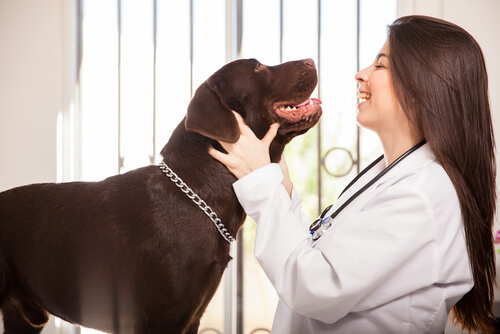Tumors in Your Dog's Mouth

As with humans, animals can develop tumors too. These tend to be just as dangerous and lethal as they are for us, and so many species are at risk from cancer. Find out what to do if you find tumors in your dog’s mouth.
In the case of “man’s best friend”, it has to be said that one of the most common types of cancer that usually occurs in them is mouth cancer. This is extremely uncomfortable because it limits their ability to eat, bark, or drink water, as having the tumor outside or inside the muzzle makes it impossible for them to lead a normal life.
However, encouragingly, specialists in the field have determined that unless they’re malignant, this type of tumors, although aggressive, metastasize very infrequently. Based on the above, we’ll now talk about tumors in your dog’s mouth.
The causes of tumors in your dog’s mouth

Although it may seem unbelievable, it has been impossible to determine exactly why dogs suffer from this terrible disease.
However, some specialists have stated that it could occur as a result of diverse carcinogenic agents that are inhaled by the dog when they sniff around the ground and almost everything that surrounds them.
Likewise, the particles that generate cancer can be consumed in different types of food that contain chemical products and artificial preservatives. These carcinogenic agents will multiply when they enter the canine’s body and will cause the growth of cancerous cells.
It’s important to highlight that tumors in the mouth are usually suffered by dogs that are between 6 and 22 months old.
What’s more peculiar is that, even though any dog can suffer from tumors in the mouth, some breeds are particularly affected. They are the following:
- Cocker Spaniel
- Poodle
- Golden Retriever
- German Shepherd
- Boxer
Symptoms
As is to be expected, when a dog suffers from this condition, there are certain signs that will help you see whether they have a mouth tumor or not. These are as follows:
- One of the first symptoms is usually a sudden change in the dog’s breath, which will have a particular odor that shows that they have this particular health problem.
- Another of the most common symptoms is the presence of blood in its saliva, which you’ll notice mainly when the dog is drinking water.
- Difficulty chewing food.
- When the problem starts to develop, it’ll be impossible for them to open their mouth.
- Displacement or loss of teeth.
- Obviously, the main and most noticeable symptom is the presence of a mass in the cavity.
Once you notice any of these signs, you should immediately take them to the veterinarian, who will perform a careful examination with an inspection of the oral cavity, looking out for any kind of change that has occurred in the natural shape of the gums. They’ll take a biopsy and send it off to the laboratory to rule out a malignant tumor.
Treatment

Once you have done this, the specialist will check out the dog’s medical history in order to give a proper diagnosis and determine to what extent the carcinogenic cells have spread in the body.
They’ll also thoroughly check the lymph nodes in the mouth, face, neck, and lymph glands to see if the cancer has spread beyond these parts.
To treat these types of tumors when they’re benign, the best solution is simply to perform surgery to remove the affected part of the jaw.
However, this is practically impossible to treat when the tumor has spread to other areas, although surgery is still the best treatment that can be given to dogs in these cases.
Once the surgery has been performed, the dog will suffer a lot of pain in the mouth area, so the following is recommended to alleviate it:
- If the pain is mild, you should give your dog non-steroidal anti-inflammatory drugs.
- If the pain is moderate, you should give them weak opiates such as codeine and tramadol.
- When the pain is unbearable, strong opiates such as morphine are best.
As you will have realized, tumors in the mouth are an extremely delicate issue, but we hope today’s article will have been helpful to you should your dog be showing any of the symptoms that we have mentioned.
As with humans, animals can develop tumors too. These tend to be just as dangerous and lethal as they are for us, and so many species are at risk from cancer. Find out what to do if you find tumors in your dog’s mouth.
In the case of “man’s best friend”, it has to be said that one of the most common types of cancer that usually occurs in them is mouth cancer. This is extremely uncomfortable because it limits their ability to eat, bark, or drink water, as having the tumor outside or inside the muzzle makes it impossible for them to lead a normal life.
However, encouragingly, specialists in the field have determined that unless they’re malignant, this type of tumors, although aggressive, metastasize very infrequently. Based on the above, we’ll now talk about tumors in your dog’s mouth.
The causes of tumors in your dog’s mouth

Although it may seem unbelievable, it has been impossible to determine exactly why dogs suffer from this terrible disease.
However, some specialists have stated that it could occur as a result of diverse carcinogenic agents that are inhaled by the dog when they sniff around the ground and almost everything that surrounds them.
Likewise, the particles that generate cancer can be consumed in different types of food that contain chemical products and artificial preservatives. These carcinogenic agents will multiply when they enter the canine’s body and will cause the growth of cancerous cells.
It’s important to highlight that tumors in the mouth are usually suffered by dogs that are between 6 and 22 months old.
What’s more peculiar is that, even though any dog can suffer from tumors in the mouth, some breeds are particularly affected. They are the following:
- Cocker Spaniel
- Poodle
- Golden Retriever
- German Shepherd
- Boxer
Symptoms
As is to be expected, when a dog suffers from this condition, there are certain signs that will help you see whether they have a mouth tumor or not. These are as follows:
- One of the first symptoms is usually a sudden change in the dog’s breath, which will have a particular odor that shows that they have this particular health problem.
- Another of the most common symptoms is the presence of blood in its saliva, which you’ll notice mainly when the dog is drinking water.
- Difficulty chewing food.
- When the problem starts to develop, it’ll be impossible for them to open their mouth.
- Displacement or loss of teeth.
- Obviously, the main and most noticeable symptom is the presence of a mass in the cavity.
Once you notice any of these signs, you should immediately take them to the veterinarian, who will perform a careful examination with an inspection of the oral cavity, looking out for any kind of change that has occurred in the natural shape of the gums. They’ll take a biopsy and send it off to the laboratory to rule out a malignant tumor.
Treatment

Once you have done this, the specialist will check out the dog’s medical history in order to give a proper diagnosis and determine to what extent the carcinogenic cells have spread in the body.
They’ll also thoroughly check the lymph nodes in the mouth, face, neck, and lymph glands to see if the cancer has spread beyond these parts.
To treat these types of tumors when they’re benign, the best solution is simply to perform surgery to remove the affected part of the jaw.
However, this is practically impossible to treat when the tumor has spread to other areas, although surgery is still the best treatment that can be given to dogs in these cases.
Once the surgery has been performed, the dog will suffer a lot of pain in the mouth area, so the following is recommended to alleviate it:
- If the pain is mild, you should give your dog non-steroidal anti-inflammatory drugs.
- If the pain is moderate, you should give them weak opiates such as codeine and tramadol.
- When the pain is unbearable, strong opiates such as morphine are best.
As you will have realized, tumors in the mouth are an extremely delicate issue, but we hope today’s article will have been helpful to you should your dog be showing any of the symptoms that we have mentioned.
All cited sources were thoroughly reviewed by our team to ensure their quality, reliability, currency, and validity. The bibliography of this article was considered reliable and of academic or scientific accuracy.
- Castejón, R., Calvo, I., Trobo, J. & San Roman, F. (2003) NEOPLASIAS MALIGNAS DE ORIGEN NO ODONTOGÉNICO DE LA CAVIDAD ORAL DEL PERRO. Pequeños animales COVELMA, 34-36.
- Páucar, J., Perales, R., & Tabacchi, L. (2017). Frecuencia de neoplasias en cavidad oral de caninos y felinos, diagnosticadas histopatológicamente en el Laboratorio de Patología Veterinaria de la Universidad Nacional Mayor de San Marcos (Periodo 2007-2013). Revista de Investigaciones Veterinarias del Perú, 28(1), 201-206.
- Lucena, R., Ginel, P. J., Pérez, J., López, R., Chacón, F., & Mozos, E. (1996). Tumores de cavidad oral en el perro: estudio retrospectivo. Clínica veterinaria de pequeños animales, 16(2), 0071-76.
This text is provided for informational purposes only and does not replace consultation with a professional. If in doubt, consult your specialist.








